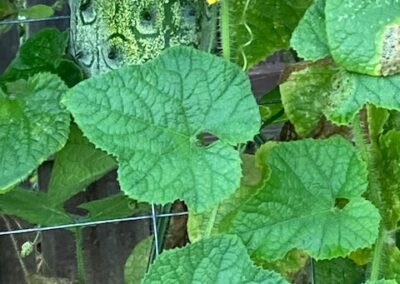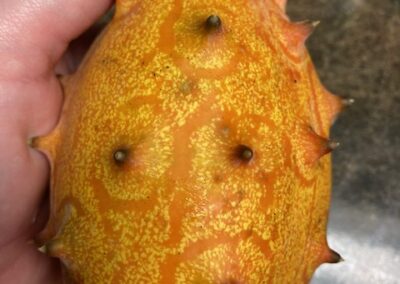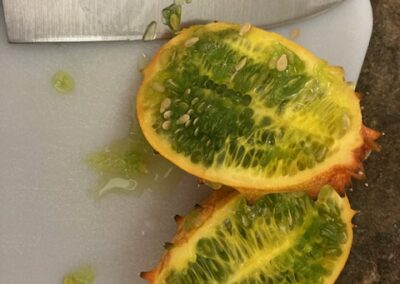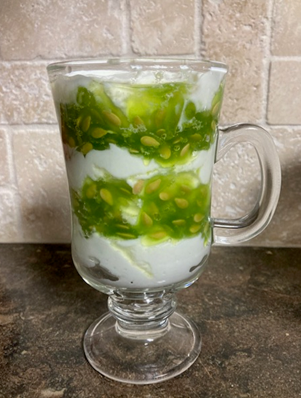
Jelly Melon, Kiwano
Native to the central and southern regions of Africa, the jelly melon is an exotic-looking fruit. The spiny melons turn a deep orange when they are ready for harvest.
|
African Horned Kiwano; Kiwano Rund |
|
Cucumis metuliferus |
|
Easy to intermediate |
|
Difficult |
|
Best guess: 5 years if properly cured, dried, and stored. Update: I had trouble getting year-old seeds to germinate. Viability may only be for one year. |
|
Annual |
|
14-21 days |
|
None |
|
1/2 inch |
|
Vine |
|
Full sun |
|
120 days |
|
April, May |
|
Yes |
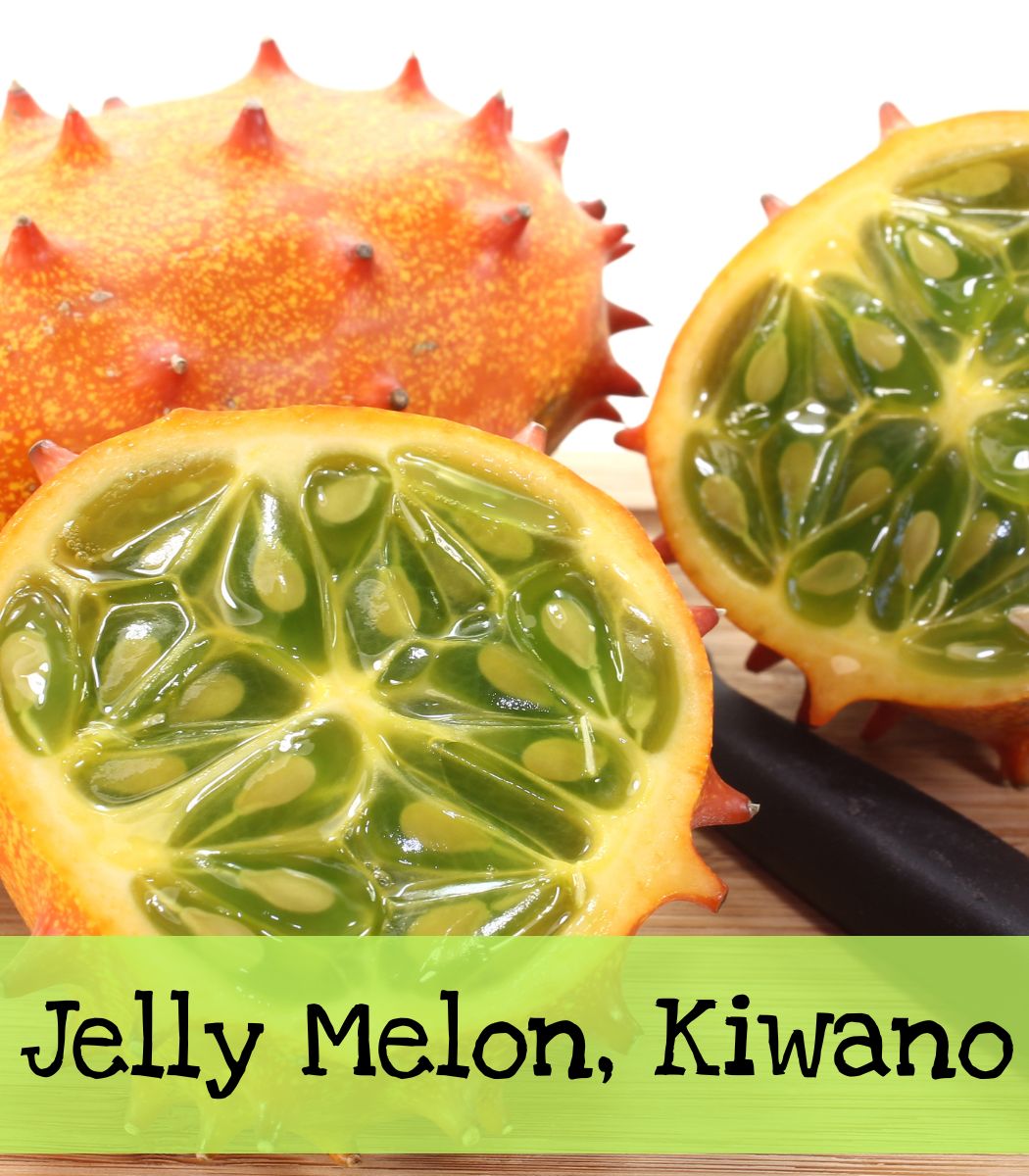
Growing Tips


When to Start
Spring: Seeds can be started indoors several weeks before the danger of frost has passed and then transplanted once temperatures are consistently above 65F.
Direct sow: After all danger of frost has passed. (May 1 for Jefferson, GA)
How to Grow
Jelly melons are slow starters. They are both slow to germinate (2-3 weeks) and slow to produce. Giving them a few weeks head start can be very beneficial. To start indoors, sow into sterile seed starting mix. Sow to a depth of 1/2 inches several weeks before the last frost. Place under grow lights. Then, after hardening off, transplant them into the garden once the temperatures are consistently above 65 F. Or they can be directly sown after ALL danger of frost has passed. No matter which you do, they will need full sun beds. Space or thin plants to 18 inches apart.
Care
While jelly melons are slow starters, once they start to set on fruit they are very prolific. It is also important to keep the plants pruned as they will try to grow over everything.
As the kiwano is in the cucumber family, its care needs are very similar. Choose a site that has adequate drainage and fertile soil. Keep the soil moist but not soggy. Trellis are helpful with space, but they grow and produce just fine rambling on the ground. Just keep in mind the fruit is very spiky and sharp. You would not want to step on one!
Harvest
The African Horned Kiwano variety is ready for harvest when it turns a bright orange color all around. This fruit has some sharp spines and gloves are recommended. It is best to cut the fruit from the vine instead of pulling it.
Pest Management
Pickleworms can be a problem. These are the caterpillar stage of a moth. If you see little holes in the fruit and little piles of the innards of the fruit near the holes, this is the result of pickle worms. One way to prevent them from getting to the fruit is to cover the fruit at night before the moths come out. This will prevent them from laying eggs. If you do this you will need to remove the covers during the day so that the pollinators can get to the flowers.
If you don’t wish to go that route, you could try companion planting. Trichogramma wasps are a predator of pickleworms. To attract them you will want to plant daisies and caraway. There are many other plants to choose from to attract this predator and others that should help. See my list of companion plants for more ideas!
My personal experience
I grew these for the first time this year (2023) and they sure were fun to grow! The were started May 1. But they were very slow to start. We did have an unusually cool spring so this might have been part of the reason, but they are just slow. I will try starting them indoors next year so that I can get fruit sooner.
The vines started to take off once we started experiencing normal average temperatures. They didn’t start to flower and set on until the very end of July. And the melons took forever to ripen. I got to try my first one in September. But once that happened, they just kept coming and coming and coming!
You will want to keep these pruned. When I cut my Achilles tendon I couldn’t get out to the garden to take care of the Jelly Melon. (My husband watered it for me.) When I finally was able to walk well enough to check on it in late fall, the vine had literally taken over the whole garden. Kind of like kudzu. I had jelly melons in my tea plants, on the ground, hanging off flowers, and they would have tried to grow into the neighbors yard, but for mowing.
When the first frost aproached, we picked all the fruit that had even the slightest bit of orange in it. I wasn’t sure if they would continue to ripen off the vine or not. Next time, I’ll pick all the melons. It took a good while, but all those green jelly melons are now bright orange and ready for eating!
I enjoy eating them by themselves and in parfaits. My favorite way is blending them into a tropical spinach smoothie!
My Tropical Spinach Smoothie
- 1-2 Handfuls of spinach (about 1 c)
- 1/2 Jelly melon
- 1/2 c Mango (fresh or frozen)
- 1/2 c Pineapple (fresh or frozen)
- 1 c Orange Juice or 1 c Almond milk
Blend till smooth and serve immediately. It should make about one tall glass of smoothie. This can also be frozen into popsicles!
Unripe Jelly Melons
The picture doesn’t do it justice. The vine is massive! I had to keep pruning it to keep it from trying to cover everything in the garden, yard, fence, etc.! It’s very prolific!
Jelly Melon cut in half length wise
The insides are weird looking, but so delicious! Scoop out with a spoon and gently squeeze the middle to remove the jelly and seeds.
Seed Saving

Isolation Distance
It is insect-dependent for pollination. Although the jelly melon is in the cucumis species, it will NOT cross with other cucumis species. There is no need to isolate UNLESS you are growing 2 different varieties of jelly melons.
Instructions
Allow fruit to mature to a deep orange and become quite soft, then scoop out the seeds and ferment to remove pulp just as you would a tomato.
Step 1: Place the pulp into a bowl. If there is not enough liquid, add enough water to help the seeds separate from the pulp.
Step 2: Let it sit in a warm spot to ferment for 2-3 days and allow mold to form. (Yes, it stinks and is gross. Put it somewhere where you won’t pass by it very often.) TIP: use a tall canning jar. This will help control some of the odor and allow you to see the progress of the seeds. Cover the top of the jar with a cheesecloth or a paper towel, securing it with a rubber band, to keep any insects out and yet allow some airflow.
Step 3: Once the layer of mold has formed, lift it off with a fork. This will make rinsing easier. Add some water and mix or shake the jar. The viable, good seeds will sink to the bottom and the bad seeds, which won’t germinate, will float. Skim off the bad seeds and toss. Pour the rest of the seed/pulp mixture through a strainer and rinse. Remove any remaining bits of mold and pulp to leave only clean seeds.
Step 4: Dry your jelly melon seeds on a piece of glass or a shiny plate out of direct sunlight—the wet seeds will stick to paper and be difficult to remove without damaging them. Shake the seeds daily to make sure they dry evenly. Don’t speed up the drying process or you could damage or kill the seeds. Once they are thoroughly dry, store dried seeds in labeled, paper seed bags. Drying could take a week or more.
Features
- African Horned Kiwano: An African heirloom. The melon turns a deep orange when ready for harvest. It is relatively easy to grow. However, it does take a while for it to set on, but once it does, it is very prolific. The melons do have spines, so gloves are recommended.
- Kiwano Rund: An African heirloom. Rounder version of the African Horned. The fruit is about 3 inches in diameter. The skin is a pale peach to ivory color. The flesh is often compared to a banana and a lemon.

As the fruit takes a while to set on and then ripen, start indoors several weeks before the last frost to get fruit sooner!
Keep the vines pruned to prevent the vines from taking over.

